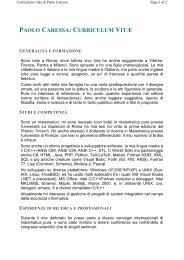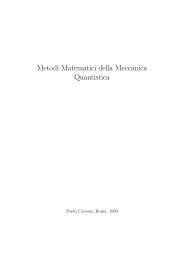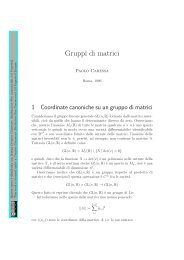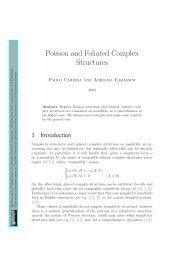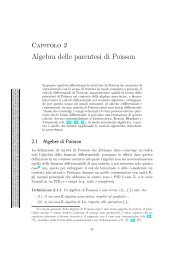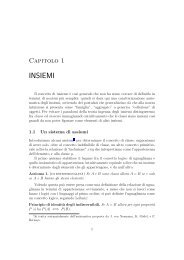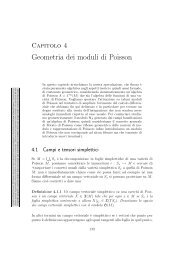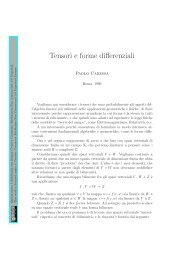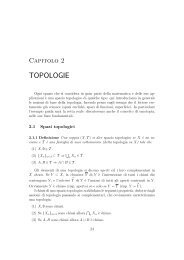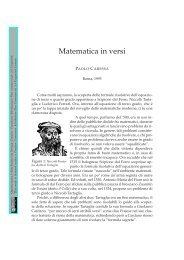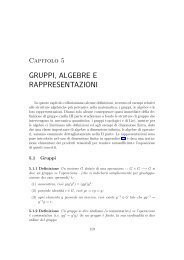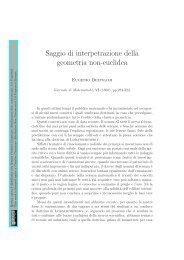20 Paolo <strong>Caressa</strong>Si <strong>di</strong>mostra allora (è un conto noioso) la seguente e notevole ident<strong>it</strong>à:H{α,β} = [Hα,Hβ]ed inoltre che queste parentesi rendono Ω 1 (A) un’algebra <strong>di</strong> Lie.Osserviamo comunque che l’ident<strong>it</strong>à precedente può esprimersi <strong>di</strong>cendoche H è un morfismo <strong>di</strong> algebre <strong>di</strong> Lie, ed in particolare che fornisce una rappresentazionelineare (tram<strong>it</strong>e le derivazioni) <strong>di</strong> Ω 1 (A) sullo spazio vettorialeA. Possiamo allora utilizzare questo fatto per definire una particolare coomologiaassociata alla struttura <strong>di</strong> <strong>Poisson</strong>, che, in un certo senso, generalizza lacoomologia <strong>di</strong> de Rham. Questa coomologia è stata defin<strong>it</strong>a da Lichnerowiczsulle varietà, ma, come si vede, la sua natura è puramente algebrica, secondola nostra definizione, che è la seguente: se supponiamo che il campo Ksul quale è defin<strong>it</strong>a l’algebra A abbia caratteristica zero, possiamo considerarela coomologia <strong>di</strong> Chevalley–Eilenberg associata alla rappresentazione Hdell’algebra <strong>di</strong> Lie Ω 1 (A). Questo vuol <strong>di</strong>re (cfr. [3]) che esiste l’operatoredefin<strong>it</strong>o come〈δρ|α 0 ∧···∧α n 〉 :=i=0∑0...n+δ : Der n (A) → Der n+1 (A)n∑(−1) i Hα i 〈ρ|α 0 ... → ∧ α i ...α n 〉+i
<strong>Strutture</strong> <strong>di</strong> <strong>Poisson</strong> 21Questo invariante è stato defin<strong>it</strong>o (in un modo <strong>di</strong>fferente) da Krasilščik e Vinogradove consente <strong>di</strong> formulare alcune estensioni della Meccanica Anal<strong>it</strong>icasulle algebre <strong>di</strong> Lie (cfr. [10]).Osserviamo che se π è il tensore <strong>di</strong> <strong>Poisson</strong>, allora è una cocatena delcomplesso <strong>di</strong> <strong>Poisson</strong> (precisamente una 2-cocatena: π ∈ Der 2 (A)), ma inrealtà è un 2-cociclo, cioè dà luogo ad una classe <strong>di</strong> coomologia [π]. Infatti〈δπ|da∧db∧dc〉 = χ a 〈π|db∧dc〉−χ b 〈π|da∧db〉+χ c 〈π|da∧db〉+−〈π|{da,db}∧dc〉+〈π|{da,dc}∧db〉−〈π|{db,dc}∧da〉= χ a {b,c}−χ b {a,c}+χ c {a,b}+−〈π|d{a,b}∧dc〉+〈π|d{a,c}∧db〉−〈π|d{b,c}∧da〉= 2({a,{b,c}}+{b,{c,a}}+{c,{a,b}})= 0(si osservi che il calcolo mostra che δπ = [π,π] s , ed infatti vale in generaleper un qualsiasi tensore controvariante ρ che δρ = [π,ρ] s ).Abbiamo dunque <strong>di</strong>mostrato che π è un cociclo e quin<strong>di</strong> dà luogo ad unaclasse <strong>di</strong> coomologia; se questa classe è zero, cioè se π è un cobordo, e quin<strong>di</strong>esiste una derivazione X tale che π = δX, allora la struttura <strong>di</strong> <strong>Poisson</strong> si<strong>di</strong>ce esatta o potenziale. Menzioniamo che, analogamente a quanto avvienesulle varietà simplettiche, la classe <strong>di</strong> coomologia del tensore <strong>di</strong> <strong>Poisson</strong> è unaostruzione alla quantizzazione geometrica dell’algebra <strong>di</strong> <strong>Poisson</strong> A.È possibile definire anche una omologia per le algebre <strong>di</strong> <strong>Poisson</strong>, generalizzandol’omologia canonica che Brylinski ha defin<strong>it</strong>o sulle varietà <strong>di</strong> <strong>Poisson</strong>(cfr. ad esempio [15]). Qui ci lim<strong>it</strong>eremo a menzionarla, ricordando che in unacerta misura è duale alla coomologia <strong>di</strong> <strong>Poisson</strong>, e può essere utilizzata perdefinire successioni spettrali e complessi doppi simili a quelli che Connes hadefin<strong>it</strong>o in Geometria Non–Commutativa.Ilseguente èunageneralizzazione<strong>di</strong>unteorema<strong>di</strong>Lichenrowicz nelnostrocontesto algebrico generale:Teorema (Lichnerowicz–Krasilščik) 2.9 SeAèun’algebra<strong>di</strong> <strong>Poisson</strong>nondegenere, cioè tale che l’operatore H è un isomorfismo, allora per ogni n ≥ 0:H n dR(A) ∼ = H n Pos(A)Dimostrazione: Dato che H ◦ d = χ e H è un isomorfismo, si ha che lerappresentazioni dell’algebra <strong>di</strong> Lie Der(A) ∼ = Ω 1 (A) (isomorfismo <strong>di</strong> algebre<strong>di</strong> Lie per ipotesi):ι : Der(A) → gl(A) e H : Ω 1 (A) → gl(A)




